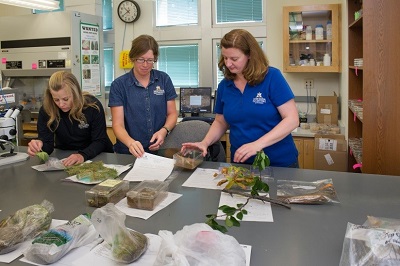Schutter Diagnostic Lab 2015 Plant Identification Summary- January 2016
Download this weed post on the 2015 Schutter Diagnostic Lab as a PDF
Introduction

Schutter Diagnostic Lab staff members Laurie Kerzicnik, Noelle Orloff, and Eva Grimme sort through samples received in the mail. Photo by Kelly Gorham, MSU
The Schutter Diagnostic Laboratory (SDL) at Montana State University (MSU) is provided through MSU Extension to provide plant pest identification. Services of the SDL include identification of weeds and other plants, mushrooms, plant diseases, insects, insect damage, and abiotic problems. The SDL accurately identifies plant pests and provides science-based integrated pest management options. We receive samples from MSU Extension agents, weed district coordinators, homeowners, farmers, ranchers, consultants, and anyone else interested in finding out more about plant issues.
Plant identification activities
In 2015 the SDL processed over 500 specimens for plant identification. Clients submitted plants with a variety of questions including whether a plant might be noxious or invasive, toxic, or good quality forage. Forty seven percent of specimens were exotic plants, representing 145 unique species. The most commonly submitted exotic species were field cottonrose (Logfia arvensis, 8), catchweed (Asperugo procumbens, 6), hoary alyssum (Berteroa incana, 6), and quackgrass (Elytrigian repens, 6). Native plants accounted for 34% of specimens, representing 141 unique species. The most common native species were horseweed (Conyza canadensis, 7), sixweeks fescue (Vulpia octoflora, 4), and Rocky Mountain bee plant (Cleome serrulata, 3). Twenty two state-listed noxious weeds were submitted representing 10 unique species (Table, below). All noxious weeds submitted were priority 2A or 2B species, meaning that they are either common or abundant in Montana. We also received specimens suspected of being high priority noxious weeds that were not. For example, two specimens suspected to be Montana’s newest noxious weed, common reed (Phragmites australis spp. Australis), were submitted and both were identified as a native subspecies (P. australis spp. americanus). Two specimens were submitted that were suspected of being scotch broom (Cytisus scoparium), but neither specimen was.
|
Species
|
County
|
Priority
|
|---|---|---|
|
Blueweed
|
Ravalli
|
2A |
|
Canada thistle
|
Gallatin
|
2A
|
|
Common tansy
|
Gallatin, Powder River
|
2B
|
|
Eurasian watermilfoil
|
Gallatin
|
2A
|
|
Hoary alyssum
|
Flathead, Gallatin, Silver Bow
|
2B
|
|
Houndstongue
|
Gallatin, Glacier
|
2B
|
|
Oxeye daisy
|
Gallatin
|
2B
|
|
Russian knapweed
|
Garfield
|
2B
|
|
Spotted knapweed
|
Silver Bow
|
2B
|
|
St. John's Wort
|
Big Horn
|
2B
|
|
Tall buttercup
|
Gallatin
|
2A
|
Sample sources
Plant samples came from 49 of 56 Montana counties, one county in Arizona, one county in Idaho, and one Canadian province. The highest submission numbers were from Gallatin, Ravalli, and Silver Bow Counties with 140, 44, and 29 submissions, respectively. Submissions were greatest in June and July with 114 samples each of those months. Noncommercial sources (i.e. homeowners, small acreage landowners) accounted for 84% of submissions while commercial sources (i.e. farmers, ranchers, consultants) accounted for 16% of all submissions.
Additional information
If you have a plant you would like help identifying, you can 1) take the plant to your county Extension agent (for Montana residents) or, 2) submit a sample to SDL for identification. This is a free service for Montana residents, and out-of-state clients may be charged a fee. You can find contact information, submission instructions, fee information, and forms online on the Schutter Diagnostic Lab website.
